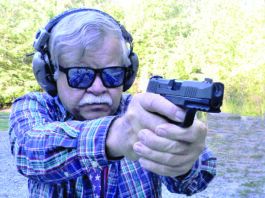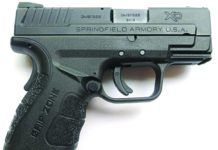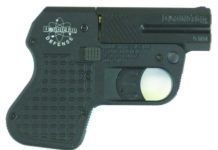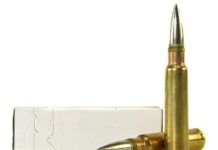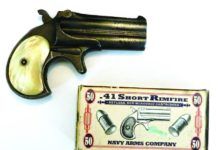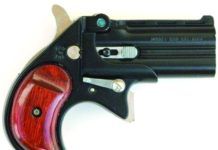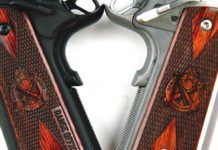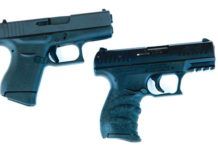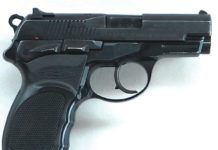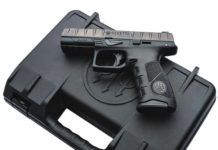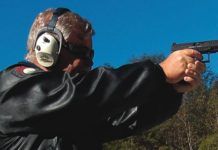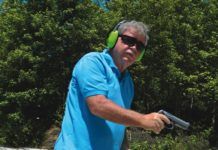Springfield Armory XD Mod.2 3.0-Inch Subcompact XDG9801HCSP 9mm Luger, $556
Both XD Mod.2s also have a slimmer frame that measures 1.19 inches for the 9mm model and 1.2 inches for the 45 ACP model, thinner than the 9mm XD 3-inch subcompact and only 0.2 inch thicker than the single-stack 9mm XD-S 3.3 model. Both the 9mm and 45 ACP Mod.2 pistols have heights of 4.75 inches with the flush-fit magazine, same as the XD 3-inch subcompact. The XD-S 3.3 model is 4.43 inches high, making the Mod.2 pistols just 0.3 inch taller.
Aft of the trigger on both sides the frame is a scalloped-out section so the trigger finger of a left- or right-handed shooter lays more comfortably in the ready position. The high beavertail safety and the rear of the trigger guard is relieved to provide a high hand hold on the pistols, making the bore axis closer to the shooter's hand. Team members with small-to-average-size hands, as well as those with large hands, found the Mod.2 pistols comfortable to grip. In some instances, testers had to curl their small finger under the floorplate, while others had enough grip to stay on the lip of the flush-fit magazine floorplate.
Range Data
The team was split even before we put in any trigger time, with the 45 ACP aficionados against the 9mm clan. But as range testing progressed, we found ourselves liking the 9mm more. At first, we expected the XD Mod.2 pistols would shift in our grip during recoil, but we found quite the opposite to be true. The grip textures offered good friction against our hands without abrasion.
We also saw the sights were large and offered fast target acquisition. The pistols likewise pointed well for close work and continued to perform out to 25 yards. Most felt the pistols acted like full-size pistols.
Recoil felt less stout in the Mod.2s compared to other smaller pistols we are familiar with. We attribute this to the grip, lighter slide, and dual-spring recoil guide rod. There was some take up on the triggers — which is fine considering these are defensive pistols — as long as the breaks were consistent, which they were.
With average accuracy of about 1.5-inch groups with the 9mm model and 2-inch groups with the 45 ACP at 25 yards, we were happy. The Mod.2 in 9mm was more pleasant to shoot than the 45 ACP, though the 45 ACP was nowhere near the brute we though it would be. We could also recover faster using the 9mm model, so a follow-up shot was quicker.
Handgun Stats: DoubleTap Defense Tactical Derringer 9mm Luger, $345
The pistol is so difficult to fire due to the heavy recoil, realistic practice is out of the question, at least for our shooters.
Range Data
To collect accuracy data, we fired five-shot groups off a solid bench rest. Distance was 5 yards. We recorded velocities with a Shooting Chrony Master Chronograph. The first sky screen was set 10 feet from the muzzle.
Derringer Shoot-out: DoubleTap, Cobra, American Derringer Co.
Meet the derringer, an anomalous little pocket pistol of which there are many types. Gun Tests tested 3 of these handguns to see if they are worth the purchase. Turns out, they might be better for show than for showdown. The original derringer was a product of one Henry Deringer, a 19th-century maker of small muzzleloading pocket pistols. His original Philadelphia Deringer percussion-lock pistols were usually 41 caliber and varied in length from 1.5 to 6 inches. The most notable use of a Deringer was by John Wilkes Booth, who shot President Abraham Lincoln. Once cartridge guns came into being, Deringer's name was misspelled often enough to become the generic description of a small pocket pistol of limited capacity, often with a sliding or pivoting breech block. They commonly carried two shots, although some were designed for up to four shots. They were sometimes called "muff pistols" because they were carried in a muff or hand warmer used in the winter. Also, the derringer became a backup favorite of Western marshals and outlaws alike.
Among the most successful of these handguns was the Remington Derringer. In fact, the Remington's profile is associated more with the derringer than Deringer's original single-shot black-powder pistol. The Remington doubled the payload with twin barrels in the over-and-under fashion. The Remington barrels pivot upward to load and unload, and a pivoting cam on the firing pin fired first one barrel then the other. The Remington Derringer was made of iron, never steel, and was manufactured from 1866 to 1935. That is a long run for a relatively primitive handgun. The .41 Short Rimfire it fired was no powerhouse, exiting the Remington barrel at 425 fps. There have been many copies of the Remington, and two of the pistols tested in this report are copies of the Remington, namely the Cobra Enterprises CB9 Big Bore Derringer 9mm Luger, $151; and the American Derringer Company Standard Model 38 Special, which we bought used for $212. The third gun in the test was a new take on the derringer concept, the DoubleTap Defense Tactical Pocket Pistol in 9mm Luger, $499 MSRP and a $345 counter price from Cheaper Than Dirt!
The derringers were all easy to carry well, and the balance and flat profile make for a nice pocket or vest pistol. However, after testing both the derringer concept and the individual derringers, we think the money spent on these handguns would be better used elsewhere. But we graded on a "derringer" scale relative to each other, even though none of our test shooters would buy one. Here's what we found.
Handgun Stats: Cobra Enterprises CB9 Big Bore Derringer 9mm Luger, $151
The Cobra Derringer is a modern attempt to provide a useful pocket firearm. Operation is straightforward, although some attention to detail is needed to carry safely.
Springfield 9mm 1911s: Loaded Versus Range Officer Showdown
There are many good reasons for purchasing a 1911 in the non-traditional 9mm Luger cartridge. Compared to 45 ACP, 38 Super, and 10mm, 9mm Luger ammunition is less expensive and easy to come by. Also, the 9mm is only improved when fired from the 1911, with that platform's solid ergonomics, reliability, and distinctive appearance. In a 1911, the 9mm is easy to shoot well, despite a history in which 9mm target guns were seldom as accurate as a properly set up 45. As it turns out, the 9mm 1911 with modern ammunition is plenty accurate. Some shooters might also worry that 9mm 1911s might be less reliable, but we can only say that in our small sample of hundreds of rounds, two tested 1911 9mm handguns were reliable.
Where do such guns fit in? For one, the 9mm 1911 is a great target and competition handgun. Just as a cowboy-action shooter may choose a 38 Special SAA for economy and low recoil, an IDPA shooter may find the 9mm affords economical practice without creating waves in the arm from recoil. The self-defense shooter need not worry either, because with +P loads, the 9mm is no slouch in the wound-ballistics department.
We have had calls to choose between two closely matched stablemates from Springfield Armory, and both the Loaded Target PI9134LP and the Range Officer PI9129LP are traditional full-size 9mm pistols. This simply means that they are based upon the 45 ACP's frame. They are very similar to 38 Super pistols, save for a breech face of 0.384 versus 0.405 inch for the 38 Super. By changing a barrel and opening the breech face, the 9mm pistol may be converted to 38 Super. As you may imagine, converting a 38 Super to 9mm is a bit easier since the larger breechface usually works okay with both cartridges. (Exceptions: The Para USA LDA 9 and the Springfield EMP 9mm are 9mm pistols that are a bit smaller in dimension than the full-size Springfield pistols. They cannot be converted to the 38 Super.)
The full-size 9mm handguns are designed to fill a niche for those favoring the 9mm, or those simply wishing to own a lighter-kicking 1911 than one chambered in 45 ACP or 40 S&W.
The 9mm Range Officer has the same forged national match frame and slide as the Trophy Match and TRP 1911s. It gets the same precision fit as those more expensive pistols, Springfield says. Likewise, it uses the same match-grade stainless-steel barrel and bushing and is topped with a fully-adjustable rear target sight. This is a great help to us in adjusting point of aim to point of impact when we're shooting different bullet weights. It has a single-sided thumb safety.
The Loaded 9mm Stainless Steel has a polished finish on the flat surfaces and bead-blasted matte finish on the rounded areas. The 5-inch barrel is a match-grade stainless steel unit. The slide features slanted serrations on the front and rear, where the RO has only rear cuts. The mainspring housing is flat and includes the company's integral locking system, or I.L.S., which replaces the mainspring housing of the handgun. When engaged, the I.L.S. prevents the hammer from moving by locking the mainspring cap, making the gun inoperable. Elsewhere, the pistol has a lightweight Delta hammer and a beavertail grip safety with raised memory pad for positive engagement. The extended thumb safety is ambidextrous, and its long aluminum match-grade trigger separate it from the RO. The pistol is fitted with a two-piece full-length guide rod. The grips are held in place with Torx grip screws that look nice and distinguish it from the RO.
During the evaluation, both handguns were field stripped. Interestingly, the Range Officer slide easily slipped on the Loaded Model Frame. The Loaded Model slide, however, was too tight on the Range Officer frame to function. Since modern 1911 handguns are not disassembled and thrown into a barrel on Guadalcanal for cleaning, then assembled regardless of original set up, this is acceptable and also interesting. The Range Officer seemed to have the tighter barrel bushing lockup. The barrel was a tight fit overall. We were surprised that the barrel bushing was only finger tight with the Range Officer.
But what matters is the shooting, and what our team found is that these 1911s chambered in 9mm Luger make for a very pleasurable shooting experience. An accurate 1911 in 9mm is even more enjoyable. Here's more of what we learned about them when firing them side by side:
Two New 9mm Compacts from Glock and Walther Square Off
The compact 9mm pistol market is hot, and two of the newer additions to the marketplace are the Glock 43 Subcompact Slimline G43 PI4350201, $499, and the Walther Concealed Carry Pistol CCP 5080300, $452. The Glock is a long-awaited single-stack version of the other Glock pistols, but we found the G43 to be a re-engineered pistol that isn't simply a single-stack Glock 26. The frame design is a good one for personal defense if you need a pistol this size. The Walther CCP is a bit larger, so it holds two more cartridges and proved more accurate. The Walther also featured a light rail. So, in our view, we had two pistols that fit the same niche for concealed carry, but we wondered how the size and capacity issues would strike our testers.
We should mention that the raters for this test were a good mix in age and experience, from early twenties to early sixties. Among the shooters involved in this test were one with more than 40 years of shooting experience, and another has operated a respected gunsmith operation for 30 years. A third was a military intelligence officer; a fourth was a 50-ish female who carries daily, and the fifth was a college-age female who is an NRA-certified instructor.
During the firing test, both pistols were carried in a Barber Chameleon holster ($29.95, postage included, from BarberLeatherWorks.com) This affordable holster is well made of quality leather, and it offers a belt loop for use as a belt slide. There is a strong steel clip for inside-the-waistband carry. We used the holster as a belt slide for both pistols during this test.
What we didn't anticipate was the Walther getting the lion's share of attention — but not for good reasons. Because the pistol did not work to our satisfaction, we explored its operating system in depth, attempting to find remedies that we could disclose to readers who might prefer the CCP for one reason or another. Here's what we found:
Bersas UC Thunder Pro Versus S&Ws 908
When it comes to personal defense, handgun owners have many strong preferences — cultural, generational, or even institutional. Former peace officers may prefer a pistol similar to the service gun they carried at work, and soldiers often choose a Beretta because they got used to feel of an M9. One of these preferences is for a double-action first-shot handgun, which some Gun Tests readers have mentioned in comments to the editor. While personal preferences are important and heft and feel mean a lot in concealed carry, the subjective cannot outweigh objective features. The handgun must exhibit good reliability, safe operation, and practical accuracy.
Two such handguns chambered in 9mm Luger we hoped would produce these qualities were a Smith & Wesson 908 and a Bersa 9mm. The Bersa has been known as the Mini Firestorm or the Bersa Pro, and is currently named the Thunder Pro Ultra Compact. We previously had tested (May 2006) a full-size Bersa Thunder 9 and said "Buy It." We liked the workmanship, looks, feel, and performance of the 18-shot Bersa. Further, "If you want or need a good DA/SA nine that will shoot from dawn to dusk on one loading, this is an excellent choice, we thought. The gun looked about as good inside as it did out, and that inspired confidence." In that review, we also mentioned "a smaller overall version…," which is the Thunder Pro Ultra Compact. The current iteration of this handgun has a slightly different trigger guard shape, and it has a rail slot for a light or laser, but is functionally similar to our used sample. New, the 9mm comes in either a matte-black finish like our used test gun or a duotone version. There are also 45 ACP and 40 S&W chamberings in both finishes. We paid $300 for our test gun, and a new matte-black 9mm Thunder Pro UC was listed for $402 at CheaperThanDirt.com and $407 regular retail and $395 cash price at BudsGunShop.com — so around $100 more.
In the January 2005 issue, we reviewed a Smith & Wesson 908S Carry Combo against a Kahr TP9 and Kel-Tec P11. The 908S earned an "Our Pick" rating in that test, which would translate to an A grade today. Our test gun here is the blued version, the 908, which we haven't tested previously. The 908 was produced from 1996-2006. The stainless 908S was manufactured from 2003-2006. We paid $350 for our used 908, but we have seen them listed for $50 less.
To conduct combat firing, we loaded the Winchester 115-grain full-metal-jacket rounds. Our shooters drew the pistols from a Rinehart Leather belt-slide holster (RinehartLeather.com). The drills began with a pistol fully loaded and hammer down with the safety on. We fired the first shot double action and transitioned, firing the remainder of the group single action. It was not difficult to make center hits at 5, 7, and 10 yards with either handgun. But we did have a preference, which we express below:
Beretta Unveils APX Striker Gun
Beretta's APX, a new striker-fired full-size pistol in 9x19mm, 9x21mm IMI and 40 Smith & Wesson cartridges, debuted at the 2015 International Defence Exhibition & Conference IDEX expo in Abu Dhabi Feb. 22.
"IDEX is one of the first venues where defense contractors present their wares to worldwide military customers and Beretta felt this was the ideal environment to present the international offering of its APX pistol," said Carlo Ferlito, general manager of Beretta and Beretta Defense Technologies (BDT) vice president.
Beretta intends to market a variant for the commercial market later this year. The new Beretta APX has an ergonomically-molded reinforced polymer frame fitted with a built-in MIL-STD-1913 Picatinny rail, interchangable backstraps and grip panels, and a modified Browning locking system. The APX is 7.56 inches long with a 4.25-inch barrel.
The trigger can be considered a light double action, with a 6-pound break, 0.2 inch of travel, and a 0.12-inch reset. The rear portion of the striker slightly protrudes from a round slot on the back of the slide as a loaded-chamber indicator.
The slide is machined from stainless steel and has a nitride coating that reduces glare, scratches, and corrosion. Other features include wide front and rear slide serrations, three-dot sights dovetailed into the slide, and no manual safety save for a Glock-style trigger safety.
Ferlito said, "Beretta waited to enter the striker-fired market until we had a pistol we knew would meet the needs of the operator. The APX has been more than three years in development. We tested it extensively with professional end users and incorporated that feedback at every opportunity. The result is a pistol platform that delivers superior performance in durability, reliability, accuracy and ergonomics."
A slot on the frame allows the use of a tool to decock it before it can be field-stripped by operating a lever found on the left side of the frame.
An optional manual safety system will be available upon request, consisting of a frame-mounted two-position switch. A reversible magazine-release catch and a factory ambidextrous slide stop/hold open release lever help make the pistol suitable for left- or right-handed shooters.
Supplied black double-stack metal magazines have polymer bottom pads and offer 17-round capacities in 9x19mm NATO and 15-round capacities in 9x21mm IMI (9 Italian) and 40 Smith & Wesson.
Polymer-Frame 9mm Shoot Out: P320 Versus PPQ M2 Vs. VP9
During the past few months, SIG Sauer, Walther, and Heckler & Koch have introduced pistols that feature striker-fired actions. These handguns are designed to compete for the hearts and minds of institutional buyers and concealed-carry-permit holsters as well. The improvement in rapid-fire combat shooting is provable, and absolute accuracy is improved over the original SIG P250, Walther P99 and HK P30. The question is, which handgun is the most improved and the best buy for the money — that is, the most reliable and accurate?
In this test of three 9mm striker-fired models, we were firing handguns intended for personal defense in the home, concealed carry, and practical competition. We are certain each maker is hoping to compete with Glock for institutional sales as well. At first glance, the handguns appeared similar. Each featured a polymer frame, a light rail, and similar sights. Each was relatively simple to operate. None had a manual safety as part of the design. Some features, such as the sights and the magazines, were similar. A casual shooter might sign off on all three handguns, but that isn't what we do.
Our shooters noticed the trigger actions were markedly different, and grip texturing and handling were considerably different. As the firing sessions progressed and the brass stacked up, the shoot out turned into a strong challenge between the Walther and the HK pistol. These worthy competitors traded places several times in the firing evaluations. The SIG P320 brought up the rear, in our estimation. Here's why:
9mms: New Beretta 92 Compact Versus Used SIG Sauer P228
Two pistol makers that have knocked heads in police and military competitions for more than 30 years are SIG Sauer and Beretta. The Beretta 92 and the SIG P226 engaged in a hotly contested and much debated U.S. Military trial. After the dust settled, Beretta won that lucrative contract. However, the Navy did not accept the Beretta and instead adopted the SIG. American police agencies have used both in large numbers, with the SIG often hampered by a higher price. Recently, the French Army and police forces gave SIG the largest single peacetime order for handguns in history. Certainly, both makes enjoy enviable reputations. But at Gun Tests, all makers start on the same footing, reputation or not.
The raters were led toward this test by external factors. In one case, a family member was looking for a good, clean SIG P228 as a carry gun. Since the P228 is out of production, replaced by the heavier P229 or M11 A1, the SIG P228 would have to be a used gun. (Occasionally, a new-in-the-box P228 is seen at a premium.) The other instigator was an e-mail from Afghanistan. A young soldier told her father-in-law, I want a Beretta for my own when I get home! After two tours in Iraq and the tour in Afghanistan, this well-trained soldier had great respect for the Beretta. However, she did ask if there were a shorter, lighter version of the pistol.There is a compact version of the 92FS, but it is seldom seen. The question was, would the self-defense shooter be better off with the new Beretta or the used SIG, if each could be found within a few dollars of the other?
This would be a tough contest. Among our raters, one has over 20 years of police experience, including training several agencies on the SIG. Another is a military intelligence officer who has deployed the Beretta from Europe to the Pacific and just returned from 14 months with the Beretta as a daily companion. Other raters had experience with both pistols. So the deck wasnt stacked in favor of either handgun.
Common aspects of the guns include aluminum frames and steel slides. Each features a double-action first-shot trigger. Each features a 13-round magazine. Beyond those areas, lock-up differs. The SIG uses angled camming surfaces to unlock, and the barrel hood butts into the slide. The Beretta locks and unlocks via an oscillating wedge. There are differences in the decockers, and handling feels very different. Heres how our shooters rated them when the pistols were shot head to head:





























